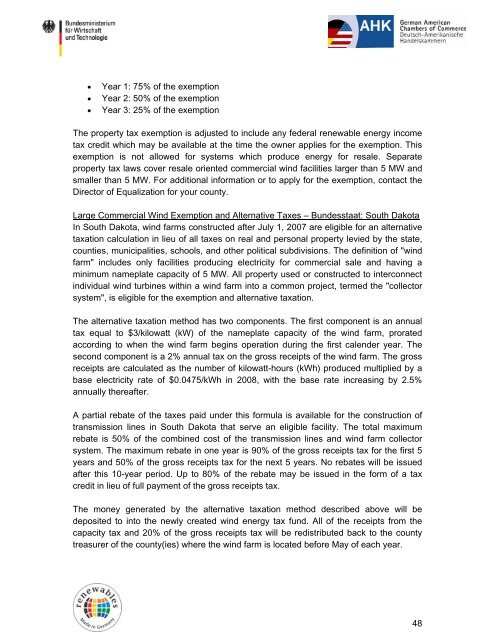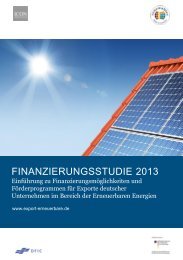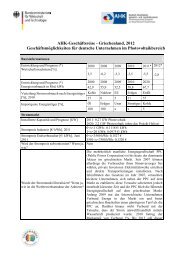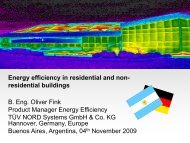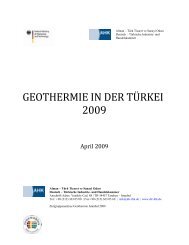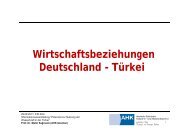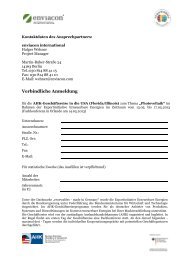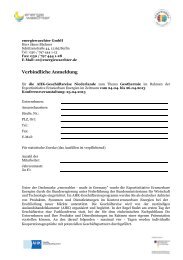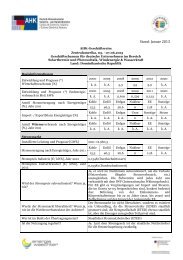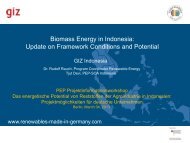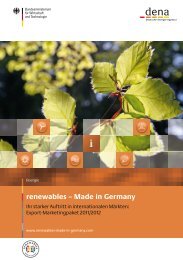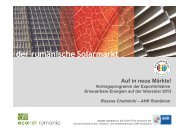PDF: 1,1 MB - Exportinitiative Erneuerbare Energien
PDF: 1,1 MB - Exportinitiative Erneuerbare Energien
PDF: 1,1 MB - Exportinitiative Erneuerbare Energien
- No tags were found...
You also want an ePaper? Increase the reach of your titles
YUMPU automatically turns print PDFs into web optimized ePapers that Google loves.
Year 1: 75% of the exemption<br />
Year 2: 50% of the exemption<br />
Year 3: 25% of the exemption<br />
The property tax exemption is adjusted to include any federal renewable energy income<br />
tax credit which may be available at the time the owner applies for the exemption. This<br />
exemption is not allowed for systems which produce energy for resale. Separate<br />
property tax laws cover resale oriented commercial wind facilities larger than 5 MW and<br />
smaller than 5 MW. For additional information or to apply for the exemption, contact the<br />
Director of Equalization for your county.<br />
Large Commercial Wind Exemption and Alternative Taxes – Bundesstaat: South Dakota<br />
In South Dakota, wind farms constructed after July 1, 2007 are eligible for an alternative<br />
taxation calculation in lieu of all taxes on real and personal property levied by the state,<br />
counties, municipalities, schools, and other political subdivisions. The definition of "wind<br />
farm" includes only facilities producing electricity for commercial sale and having a<br />
minimum nameplate capacity of 5 MW. All property used or constructed to interconnect<br />
individual wind turbines within a wind farm into a common project, termed the "collector<br />
system", is eligible for the exemption and alternative taxation.<br />
The alternative taxation method has two components. The first component is an annual<br />
tax equal to $3/kilowatt (kW) of the nameplate capacity of the wind farm, prorated<br />
according to when the wind farm begins operation during the first calender year. The<br />
second component is a 2% annual tax on the gross receipts of the wind farm. The gross<br />
receipts are calculated as the number of kilowatt-hours (kWh) produced multiplied by a<br />
base electricity rate of $0.0475/kWh in 2008, with the base rate increasing by 2.5%<br />
annually thereafter.<br />
A partial rebate of the taxes paid under this formula is available for the construction of<br />
transmission lines in South Dakota that serve an eligible facility. The total maximum<br />
rebate is 50% of the combined cost of the transmission lines and wind farm collector<br />
system. The maximum rebate in one year is 90% of the gross receipts tax for the first 5<br />
years and 50% of the gross receipts tax for the next 5 years. No rebates will be issued<br />
after this 10-year period. Up to 80% of the rebate may be issued in the form of a tax<br />
credit in lieu of full payment of the gross receipts tax.<br />
The money generated by the alternative taxation method described above will be<br />
deposited to into the newly created wind energy tax fund. All of the receipts from the<br />
capacity tax and 20% of the gross receipts tax will be redistributed back to the county<br />
treasurer of the county(ies) where the wind farm is located before May of each year.<br />
48


